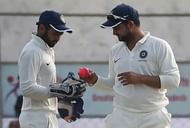The maroon Duke ball, an overcast morning, and a very English James Anderson runs into bowl, the ball drifts into the batsman while still in-the-air and then pitches and moves away from the batsman. As a kid who loved cricket, this was my version of rabbit-out-of-the-hat.
A young kid amid older ones around at a local cricket academy, I would in a charade, rub the cherry-red SG ball on my track pants just to get some of that red on my pants. That was cool! I remember how my father told me that the less-maroon Kookaburra in Australia seamed lesser than the maroon-Duke in England.
It was a Eureka moment to know that the rubbing on the trousers was not to appear cool but to shine one side of the ball to assist reverse-swing! Boy, was cricket magical!
Times change, quite quickly, indeed. On 26th August 2016, India Red won by 219 runs against India Green, and they played with a Pink ball. The Board of Control for Cricket in India (BCCI), with this, became the latest to join the bandwagon of cricket boards across the globe aiming to infuse life into the longest format of the game.
And, they’ve all decided that the drug that will further that end will be Pink. Yes, a beautiful, gleaming Pink ball (a Kookaburra ‘Turf’ for the moment).
Also Read: Problems anticipated and possible solutions with pink ball cricket in India
You read it right, the whites-clad test-cricketers will now play with a pink ball under white lights. And, as I type this, a Purist somewhere (dead or alive) is agonised. Why change the traditional format? Why replace the sophistication of cherry-red with the brash of gleaming pink? Why a dinner-break instead of a lunch-break?
Well, maybe because just like everything in this world which changes at the click of a button, cricket must also stay relevant. For, arrogance and inflexibility allure obscurity like nothing else. Ask Nokia!
But, with all the success that the pink-ball has had in Australia, New Zealand and partly in England, does it come bearing a letter-of-assurance, guaranteeing quality cricket in India too? Because, remember unlike in New Zealand, the grass isn’t exactly as lush here, and unlike Australia, cricket isn’t largely a summer sport in India.
So, the questions that the BCCI need to consider are:
#1 To what extent is the BCCI ready to control the playing environment to allow pink-ball cricket?
#2 Will the pink-ball spin on our tracks?
#3 How will due affect the gameplay as the sun sets?
When India Red came out to bat on Day 1 of the first game of the Duleep Trophy against India Green. Things just didn’t seem right. The wicket was deliberately left with a decent grass cover, it was ensured that the outfield is lush and not coarse.
All of it to make sure that the ball doesn’t lose its sheen and isn’t damaged. It was like the callous parents, who in a bid to ensure that their kid passes, assist him in preparing cheat-notes for the examination.
The result was for everyone to see, the ever-struggling Indian pacers suddenly seemed unplayable. The ball was seaming, it was swinging and it was all chaos for the batsmen. Such a contrast. An unknown entity became the fount of joy for one stakeholder and a source of uncertainty for another.
The new dress seemed to fit one so well while the other struggled to find the right ends of the dress.
Pink ball – The saviour of Test Cricket?
All of this while questions loom large. Has the BCCI rushed its decision of trying pink-ball day-night test cricket in India? Because, the pink Kookaburra is still not full-proof. It’s such a departure from the usual cherry. It doesn’t scruff as well because of an element named G7 which lends that gleam to the pink ball, which the Kookaburra surreptitiously coats on the pink-balls.
Kuldeep Yadav complained that the ball becomes tough to grip because the sheen just refuses to go away. Abhinav Mukund complained that the ball becomes tough to sight when twilight descends. All of this, remember, while the environment was controlled to suit the pink ball.
Now subtract the lush outfields, make the pitch rough and dry and introduce the dew element. The pink ball which lost its shape twice on Day-2 of the Duleep Trophy encounter with all these controlled elements, is sure to face sterner tests at venues sans these comforts.
Also Read: Red, White and Pink Balls - The Difference
The Pink ball coasted through its first international trial at the Adelaide Cricket Ground, the spectators loved it, TV viewerships soared, gate revenues bourgeoned and intrigue restored. Test cricket now sees a distant hope for revival, and it sees it under floodlights with a pink-ball.
But unlike the carpet outfields and highway wickets elsewhere, pink-ball will meet rougher blades of grass and drier wickets in India. And by the looks of it, it’s set to complain a lot.
The bold BCCI have ignited a glimmer of hope for the plunging fortunes of test cricket in India, but they must now caress this glimmer. Caress it with patience, and while they teach the young kids to adjust with the new pink-ball, they must also tell them that the maroon on their trousers looks as cool as ever.
Brand-new app in a brand-new avatar! Download CricRocket for fast cricket scores, rocket flicks, super notifications and much more! 🚀☄️


